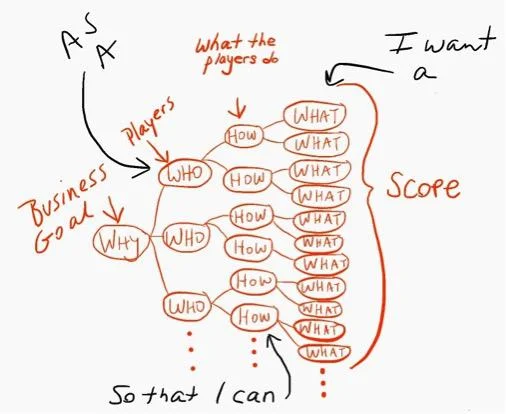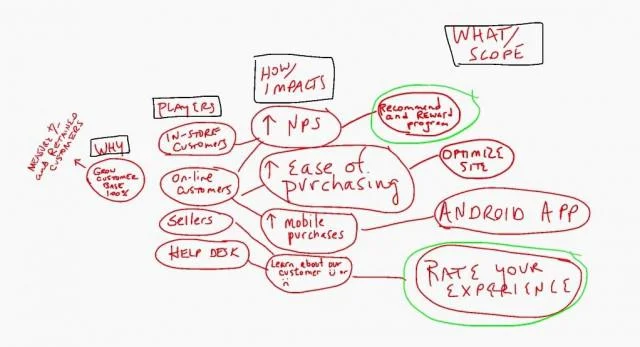There are plenty of tools that can help you develop and implement great ideas—a user story workshop, story map, value proposition canvas, business model canvas, or even simply making a backlog of things to do. In this article, we will discuss a tool called impact mapping.
Impact mapping is a strategic planning technique designed to clearly communicate assumptions of your product or service’s interdependent, dynamic relationship with people, other projects, the supporting organization, and the wider community around them.
While impact mapping is rooted in user experience strategy and design, it is increasingly being adopted in other contexts. In the DevOps community, it can help facilitate workshops and generate ideas, align stakeholders in IT projects, improve problem-solving within teams, define testing strategies, and even implement large-scale organizational improvements.
Why we like impact mapping
-
It’s fast! In very short order, you can turn ideas into features. Because of this, it fits nicely with iterative/adaptive development methods.
-
It’s a team-building event. Impact mapping facilitates collaboration and participation among people from different backgrounds, such as technical delivery experts and business users, which helps organizations tap the wisdom of crowds. When an entire team is involved in an impact-mapping session, it is more likely to "gel" around solutions.
-
Because image mapping visualizes assumptions, teams can see organizational alignment around the big picture.
What is an impact map?
Very simply, an impact map is a mind map that a team creates by answering these questions:
Why?
What is the goal you’re trying to achieve? Why are you creating this product or service?
Who?
Who can help this effort? Who can block this effort? Who are the users or consumers? Who is impacted? This is where you capture the realm of players who influence the outcome of what you’re building.
How?
This is where you link the players from the “who” branch to the perspective of your business goal. How could the players' behavior change to help you meet the business goal? How can your players help you achieve the business goal? How can they prevent or obstruct you from succeeding?
What?
What can you do, as an organization or a delivery team, to support the required impacts? These are the deliverables, features, and organizational activities you need to do to achieve the business goal.
Here’s a visual for the structure:

Notice the relationship between the impact map and user stories:
As a [player]
I want [what]
So that I can [how]
Here’s an example of an impact map created by a retail outlet that sells clothing both online and from a bricks-and-mortar store:

The retailer wants to increase its customer base by 100%. The initial results showed four major efforts—rating customer happiness/dissatisfaction, a reward-based program to recommend the store to others; a new Android application; and existing website optimization—but the retailer decided to move forward with only two: the reward program and rating customer happiness.
It’s important to measure results along the way, and since the retailer began with “why” (the business goal of increasing the customer base), they can measure as they deliver on the scope and adjust their plan along the way as needed.
Give impact mapping a try and let us know how it works for you. You can use any mind map software to create your first impact map, but you might prefer to start with pen and paper and sticky notes, or even a nice clean whiteboard.
This article was inspired by How to: Impact mapping, posted on PoDojo.com.
[See our related story, Using impact mapping to help your team experiment.]







Comments are closed.